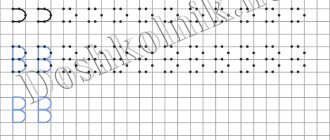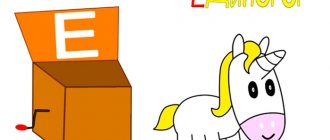MAGAZINE Preschooler.RF
Summary of a group lesson in a preparatory school group with FFNR. Class. Sound and letter E. Goals: - correct pronunciation of the sound E in syllables, words and sentences; — acquaintance with the letter “E” — to train children in pronunciation of words with a complex syllabic structure; - develop sound-letter analysis;- teach children to print the letter E; - find the correct image of the letter E among others, construct from elements; — consolidate the ability to analyze a proposal; — clarify and expand the vocabulary. Equipment: - subject pictures, the names of which contain the sound E; — a model of a train with three carriages (with two, three, four windows); kits for drawing up diagrams; proposal outline; ropes of different lengths; sample letter E; “miracle tree” with letters; split alphabet; notebooks; cards with written letters E, pencils.
Progress of the lesson. I. Organizational moment. - The one who names the vowel sounds will sit down. - Remember the words in which the vowel sound is at the beginning of the word.
II. Development of articulatory motor skills. for lips: “Tube”; "Bagel"; "Fence"; “Fence – Tube”; for the tongue: “Scapula”; "Needle"; "Cup";
III. Work on developing breathing and voice. "Peonies". Let's smell the blooming peonies: inhale through the nose - exhale through the nose; inhale through the nose - exhale through the mouth. Voice exercises: sing out the sounds: a-a-a, o-o-o, u-u-u, and-and-and.
IV. Introducing the sound E. 1. Isolating the sound E from words. — A bear came to visit us, her name is Emma. - Say this word. -What is the first sound you hear? 2. Pronouncing the sound E in chorus and individually. 3. Clarification of articulation and characteristics of the sound E (vowel sound, denoted by a red chip)
V. Automation of the sound E in syllables. 1. Repetition of syllables: gde - bde - pte - kte, pte - bde - gde - kte. 2. Sound analysis and synthesis of syllables EK, KE. Game "Live sounds". Children pronounce the syllables one by one, conduct a sound analysis: name the first sound, the second sound; after that, two children choose which sound they will make and stand in the correct sequence, each naming their own sound; the rest of the children check the correctness
VI. Automation of the sound E in words. 1.- Listen to the words and repeat: HEY, THIS, FLOOR, EDIC, ELLA, ELSA. — What is the first sound in each word? 2.–Name the pictures that are displayed on the board: SCREEN, EXCAVATOR, TOUR GUIDE, ESCALATOR, ELECTRICAL APPLIANCES, ECLAIR, ESKIMO, ELECTRIC TRAIN, ELECTRIC LOGO. (The speech therapist helps name unfamiliar words). — What is the first sound in each word? 3.-Dividing words into syllables. Game "Train". The pictures are distributed among the cars in accordance with the number of syllables in the word (after clapping each word) SCREEN, ESKIMO, ELECTRIC TRAIN, EXCAVATOR.
VII. Physical education - Children, now I will give different commands, and you will carry them out, but the “forbidden movement” will be the command “hands down.” (Hands on the waist, up, down, to the shoulders, down, crouched, waved, hands on the head, down, etc.). The most attentive one wins.
VIII. Introducing the letter E. - Let's help the bear Emma prepare for school, introduce her to the new letter E. The speech therapist shows the image of the letter in the picture and reads the verse: “This is E with an open mouth and a huge tongue.”
IX. Writing the letter E with a finger in the air, constructed from strings.
X. Printing the letter E in notebooks using dots.
XI. Find the correct letters E, circle them with a red pencil (the cards are on each child’s desk).
XII. Find the letter E on the “Miracle Tree” (count).
XIII. Sound-letter analysis of the word ECHO. 1. Sound analysis of the word, laying out the diagram. (One child performs at the board, the rest in their places) 2. Compiling a word from the letters of the split alphabet.
XIV. Compose a sentence with the word ECHO according to the proposed scheme.
.
THE CHILDREN HEARD AN ECHO. XV. Summary of the lesson and assessment of children’s activities. — What sounds did you become familiar with? - Give a description of the sound E. - What words did you remember with the sound E.
| Next > |
LiveInternetLiveInternet
Target: introduce children to the sound and letter “E”.Objectives: to consolidate the skills of distinguishing and correct pronunciation of the sound “e” in syllables, words, phrases; practice determining the place of the sound “e” in words, pronouncing words of a complex syllabic structure; learn to determine the shortest and longest word; improve the skills of sound analysis of words, typing syllables, words, sentences; develop the skill of reading sentences with different intonations; teach children to ask questions to animate and inanimate objects; consolidate the visual image of the letter, develop phonemic hearing, memory, attention.
Equipment: demonstration material - subject pictures with the sound “e”, magnetic board, colored markers, letter “e”, reading tables, ball; handouts - strings, notebooks, pens, colored pencils, cards with the letters “e” and “s”.
Progress of the lesson
I. _ Organizing time.
The one who names the first sound in the word sits down: arch, wasps, smart girl, ears, hoop, etc. .
II.
1.
Repetition of what has been covered:
- clarification of the articulation of the sounds “a”, “u”, “o” and their characteristics.
2.
Getting to know new material. The speech therapist asks a riddle:
No one saw him, but everyone heard him. Without a body - but it lives, Without a tongue - it screams. (Echo)
— What is the first sound we hear in the word “echo”?
The teacher announces the topic of the lesson.
3.
Introducing the articulation of the sound “e”. (When pronouncing the sound “e”, the lips “laugh”).
4.
Choral and individual pronunciation of the sound “e”.
5.
Characteristics of the sound "e". (The sound “e” is a vowel, it can be sung and drawn, and is indicated in red).
6.
Didactic game “Clap, don’t yawn!” The speech therapist pronounces a series of sounds, syllables, words, and the children clap their hands if they hear the sound “e”: e, a, e, u, o, e; eh, ah, uh, eh; Emma, Anna, Edik, echo, Olya.
7.
Game exercise “Speech exercise” (children repeat the chain of syllables):
ep-op-up
whoop-oop-op oop-oop-ep ip-ep-ap ep-ap-ep oop-oop-ep
8.
Didactic ball game “Where is the sound “e” hidden?” (determining the position of the sound “e” in words). Speech material: poet, elf, emblem, whatnot.
9.
Didactic game “What’s missing?” (support - object pictures with the sound “e”: popsicle, excavator, train, screen: . The speech therapist sets
5 subject pictures on a typesetting canvas, children close their eyes, the teacher removes one picture, children open their eyes and answer the question: “What’s missing?”).
10.
Pronouncing words with a complex syllabic structure, dividing words into syllables, determining the shortest and longest words: tightrope walker, electric welder, electric locomotive, electric iron, guide, electrician, crew, electrical appliance, eucalyptus.
11.
Didactic exercise “Who is this? What is this?". Continue the series:
- Who is this? This is a girl, a butterfly, a cat:
- What is this? This is a doll, a chair, a ball:
12.
Physical exercise.
Stand up together and stretch! Walk around, spin around. Hands to the right, hands to the left, and then sit down boldly. Stand up again, stretch and smile at each other.
13.
Introducing the letter “e” (showing the letter). The speech therapist reads a poem:
This is E With an open mouth and a huge tongue.
14.
Laying out the letter “E” from strings, drawing “e” in the air.
15.
Work in notebooks. Printing the letters “E”, “e”; syllables: “em”, “ep”, “et”, “ek”, “me”, “pe”, “te”, “ke”; words: “this”, “emu”, “Emma”.
Copying sentences from the board: “Emma here,” “Emu there.”
16.
Sound analysis of the word: emu (sketching of the sound diagram in notebooks).
17.
Reading sentences using interrogative and narrative intonation:
Who is this? It's a cat. Who is this? This is Emma. Who is this? This is a spider.
III.
Summary of the lesson:
1. - What sound and what letter did we get acquainted with today? Describe the sound "e".
2. - Cross out the letter that is different from the rest (work on cards):
E E E E E S E
3. Assessment of children's activities.
| Oreshkina E.A. |
https://50ds.ru/logoped/10115-frontalnoe-zanyatie-p...e-po-teme-zvuk-e—bukva-e.html






